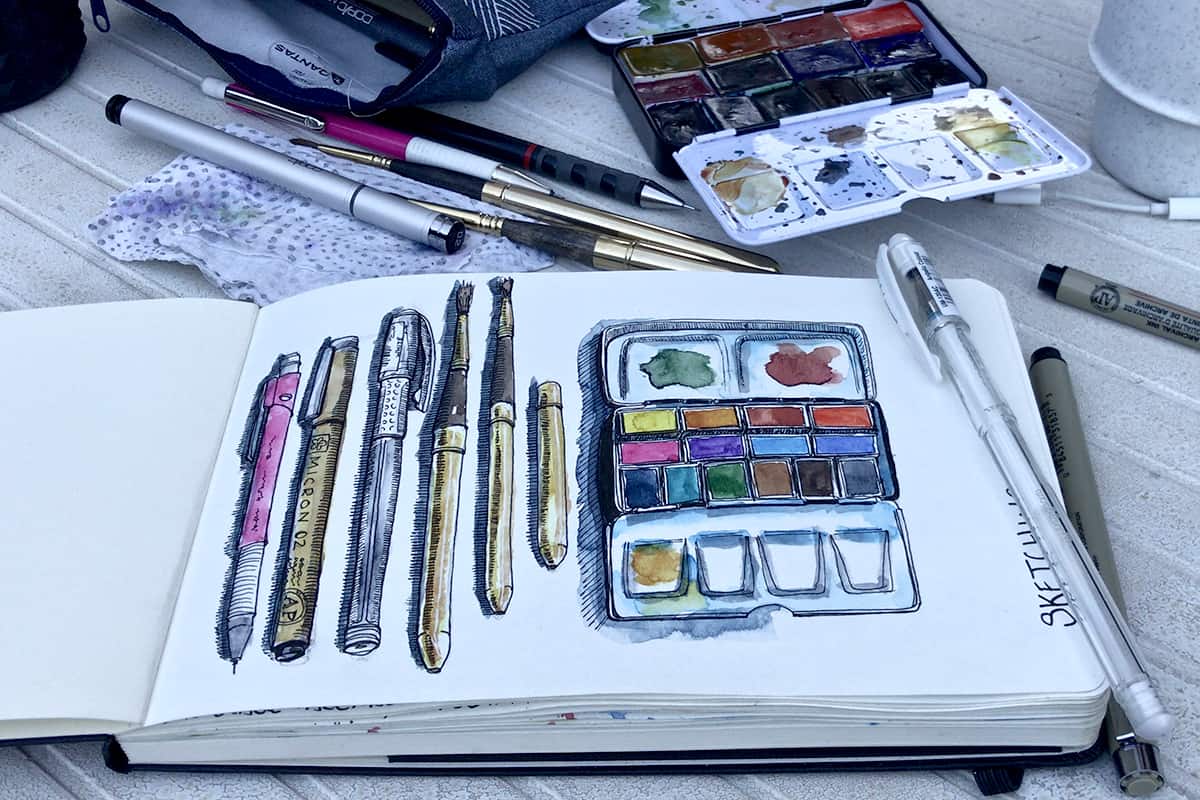What is Urban Sketching?
The act of urban sketching certainly existed long before the actual term or label of ‘urban sketching’ came about. Urban sketching essentially means sketching on location.
Rather than drawing from reference material, such as photos, inside a studio or house, for example, urban sketching is the activity of sketching from life on location.
Urban sketches tend to focus on architecture or street scenes but also include drawing people in cafes, or on their daily commute and anything in between! As long as the sketch is done from life and outside of a studio setting, then that can be considered urban sketching.
Perhaps the subtle element that differentiates urban sketching from the act of sketching on location, that artists have partaken in for decades (or centuries), is telling a story with the sketch.
The organisation, ‘Urban Sketchers‘, is a global community of artists who sketch on location. They sketch what they see and are dedicated to raising the profile of on-location sketching as a visual form of storytelling and reporting.
Origins of the Urban Sketchers Movement
Urban Sketchers is a non-profit organisation with a clear mission and manifesto. The movement was started by Gabriel Camapanario in 2007. Gabriel is based in Seattle and is a journalist and illustrator. He started an online forum and invited other sketchers who enjoy sketching on location in their local area to share the sketches with each other. The emphasis of the group was to share sketches drawn from life and on location, not from memory and not from photos.
This later evolved into a blog (urbansketchers.org) where Gabriel invited artists to share their sketches and ‘reports’ from around the world to allow others to “see the world, one drawing at a time” – the Urban Sketchers motto.
From there, the group formalised things in 2009 and registered as a non-profit organisation to better serve members. I think I became aware of the urban sketching movement somewhere around 2012. I distinctly remember taking a sketchbook to Hong Kong in 2013, excited to sketch a whole new world than I’m used to (I’m from the UK). I also remember being terrified to get my sketchbook out in public for fear of judgement!
So, if you’re just getting started, or get scared every time you try to sketch in public, I know how it feels! It’s entirely surmountable and I hope by reading some of my own experiences throughout this website and my ideas and exercises you will become more confident so you can enjoy this magical way of sketching.
Urban Sketchers Mission
Our mission is to raise the artistic, storytelling and educational value of on-location drawing, promoting its practice and connecting people around the world who draw on location where they live and travel.
Source: http://www.urbansketchers.org/p/our-mission.html
Urban Sketchers Manifesto
- We draw on location, indoors or out, capturing what we see from direct observation.
- Our drawings tell the story of our surroundings, the places we live and where we travel.
- Our drawings are a record of time and place.
- We are truthful to the scenes we witness.
- We use any kind of media and cherish our individual styles.
- We support each other and draw together.
- We share our drawings online.
- We show the world, one drawing at a time.
Urban Sketching Chapters
There are urban sketching groups all over the world, they are referred to as ‘chapters’. Official chapters have a formalised group with administrators and are registered with the Urban Sketchers organisation. You can find a list of all of the official chapters here and see if there’s one near you that you can go along and check out. A lot of urban sketching chapters have Facebook group pages, so you can always have a look there too.
There are no obligations to do anything (other than sketch) and no joining fees or anything like that. Groups usually meet once a month with a schedule of places they will be sketching at and where they will be stopping for lunch etc. It’s just a great day out with like-minded people sketching around your local area. It’s a great step to take if you are nervous about sketching in public by yourself and you get to meet local people who like sketching too.
What are Sketchcrawls?
Sketchcrawl is a term to describe a day of sketching, moving from place to place, with a sketching group. It’s like a pubcrawl but instead of moving from pub to pub, you move from sketching location to sketching location, although I suspect pubs are still involved in some sketchcrawls (I’m looking at you UK groups), whether it’s sketching them, sketching in them or having a lunchtime pitstop for a pint or two.
Usually, Urban Sketchers Chapters will organise a monthly sketchcrawl for members to spend the day sketching in a specified area, moving from one point of interest to another. Chapters may arrange events in and around and these monthly sketchcrawls but they are usually the main recurring activity.
International Urban Sketchers Symposium
Once a year the Urban Sketchers organisation hosts an international conference, the International Urban Sketchers Symposium.
The Symposium brings urban sketchers from around the globe to one city. A programme of workshops and talks is organised with top artists who consider themselves urban sketchers who teach on a variety of subjects.
The event takes place in different cities around the world each year. The very first symposium was in 2010 and was hosted in Portland, Oregon, USA.
The symposium in 2020 should have been in Hong Kong but unfortunately due to protests and fears for the safety of holding such an event, it had to be cancelled. Little did we know the Covid-19 pandemic was around the corner and so it sadly would have been cancelled anyway.
Cities that have hosted the symposium in past years include Porto (Portugal), Manchester (UK), Amsterdam, (Netherlands) and Paraty (Brazil) amongst many others.
In 2023, the first symposium since the Covid-19 outbreak put the world on pause was held in Auckland. It was the 11th international event. I was super fortunate to go along and check it out. If you would like to know more about attending an Urban Sketching Symposium for the very first time, check out this post! Or you can watch my Youtube video below:
And if you would like to see my sketchbook tour from travelling around New Zealand for a couple of weeks before the event, check out my Youtube video here.
What You Need to Get Started
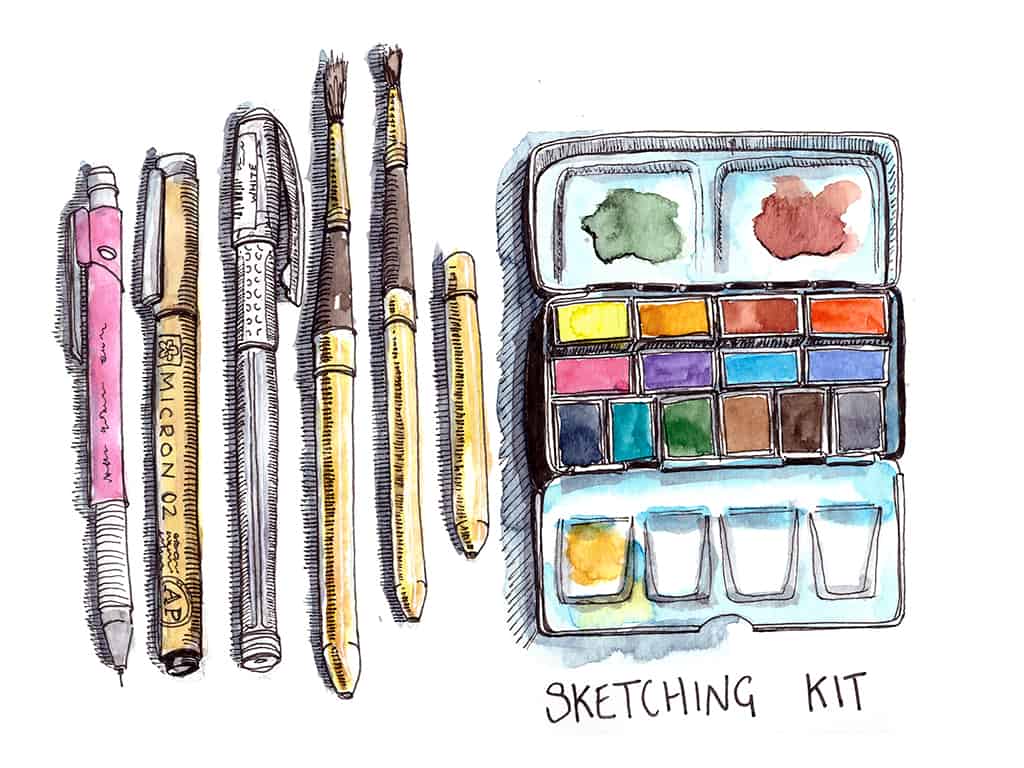
Art Supplies
- Pencil – I recommend a mechanical pencil as you don’t have to bother sharpening it all the time
- Pen – I recommend a fineliner, you can buy them in a set of different line thicknesses. They produce a consistent line and they have permanent waterproof ink. I recommend a pack of Uni Pins (on Amazon here) or a pack of Sigma Micron pens (from Amazon here).
- Watercolours – these are optional, you may just want to produce ink drawings. However, if you want to add colour, watercolour paints are great as they’re portable and can produce lovely results. There’s a bit of a learning curve but once you get the hang of it, you’ll love the results. For more information on which watercolour sets I recommend for urban sketching, check out my post here.
- Sketchbook – if you’re using watercolour paint then get a sketchbook with watercolour paper in it – see this post for my recommendations on which one. If you are using ink, then any paper is fine.
- Brushes – if you want to use watercolour then you need some brushes. I highly recommend starting off with a water brush like this one by Pentel on Amazon. For more detailed information on watercolour brushes for urban sketching, check out my post here.
- Eraser
- Paper towels (if using watercolour paint)
That’s it!
Of course, if you want to add colour your to sketch you do not have to use watercolour, you can use whatever you want! Gouache, colour pencils, markers (see my post here on how to use markers for urban sketching), oil pastels, anything really.
One of my favourite mixed-media urban sketchers is Maru Godas. I strongly urge you to check out her work on Instagram. And if you like what you see go and take her wonderful Domestika class: Pictorial Sketchbook with Gouache
It’s not a great idea to use something that requires a lot of control or that is not very portable. Urban sketching is supposed to be quick and agile so you can sketch on the fly.
Artists who paint on location with acrylic or oil paint usually set up an easel in front of a specific scene and spend 3+ hours painting. This activity is usually referred to as plein-air painting and that’s a bit different to the idea of urban sketching.
The vast majority of urban sketchers use watercolour to add colour to their sketches. I generally discuss urban sketching with traditional mediums as that’s where my interests lie, however, you can absolutely use an iPad or other tablet for urban sketching.
Urban sketcher Rob Sketcherman pretty much uses an iPad and the app Procreate exclusively. He produces awesome urban sketches with it. He offers in-person workshops across the world, keep an eye on his Instagram for when and where if you’re interested.
Check out a couple of examples of his work below:
For details of what’s currently in my own urban sketching kit currently, check out my post here.
How to Start Urban Sketching
Practice at Home
Whether you are already confident at drawing and painting or you are a complete beginner, sketching in public on location is a little nerve-wracking at first. As with anything, regular practice will help to increase your confidence.
For those who are beginner artists excited at the prospect of urban sketching but still needing to learn the art of drawing and painting, practising the basic concepts and techniques at home is a great way to step towards sketching on location.
Practising sketching from photos of similar scenes to what you might pick when outside will really help to build your sketching ability and in turn your confidence to get outside and sketch.
In this post, I talk you through how I would start an urban sketch when I’m on location. From sketching in pencil, adding details with ink, adding colour with watercolour, and adding contrast through to creating emphasis in your sketch. This is my process and is not the only way to produce a sketch, just some suggestions on how to go about getting started.
In this post, I go into further detail on how to practice the skills required for urban sketching from the comfort of your own home.
As we have been reminded by a global pandemic, you can create urban sketches from home. Just check out the hashtag #uskathome on Instagram for inspiration.
And then take the 7 Day Urban Sketching at Home challenge! Sign up here to get the prompts to your email box each day, along with a video of me completing my sketch for the day and giving you some tips!
Sketch things in your house, your pets, your family members, rooms in your house, items in the cupboards, the garden, flowers in the garden, your street…there are many many items and scenes you can sketch from life.
Once you have practised sketching at home and you feel ready, get outside and start sketching from life…this is where the magic lies!
Get Outside!
The only way to start is to throw yourself into it. But there are ways to do this to set yourself up for a useful and positive first experience. It’s always a good idea to have a bit of a plan when you head out the door to sketch, even if you deviate from the plan later on. Otherwise, as I have in the past, you can wander around aimlessly not really knowing what to do, where to go, or what to sketch and before you know it, the time you allocated to sketch had disappeared.
Most of us lead fairly busy lives so tine is a valuable commodity. If you have a rough plan, you should at least get some sketching achieved!
In this post, I have listed 16 ideas of what and where to sketch which may help inspire you to formulate your own plan of attack.
For more information and practical advice on how to overcome the fear of sketching in public check out my post here.
Did you know I have an online course?
When you’re ready…check out my course on travel sketching with ink and watercolour…I take you through 3 individual projects (pictured below) step by step in real-time and teach you my sketching process. There are over 7 hours of lessons in this course designed to help you grow your confidence, embrace mistakes and create a quirky, bold travel illustration.
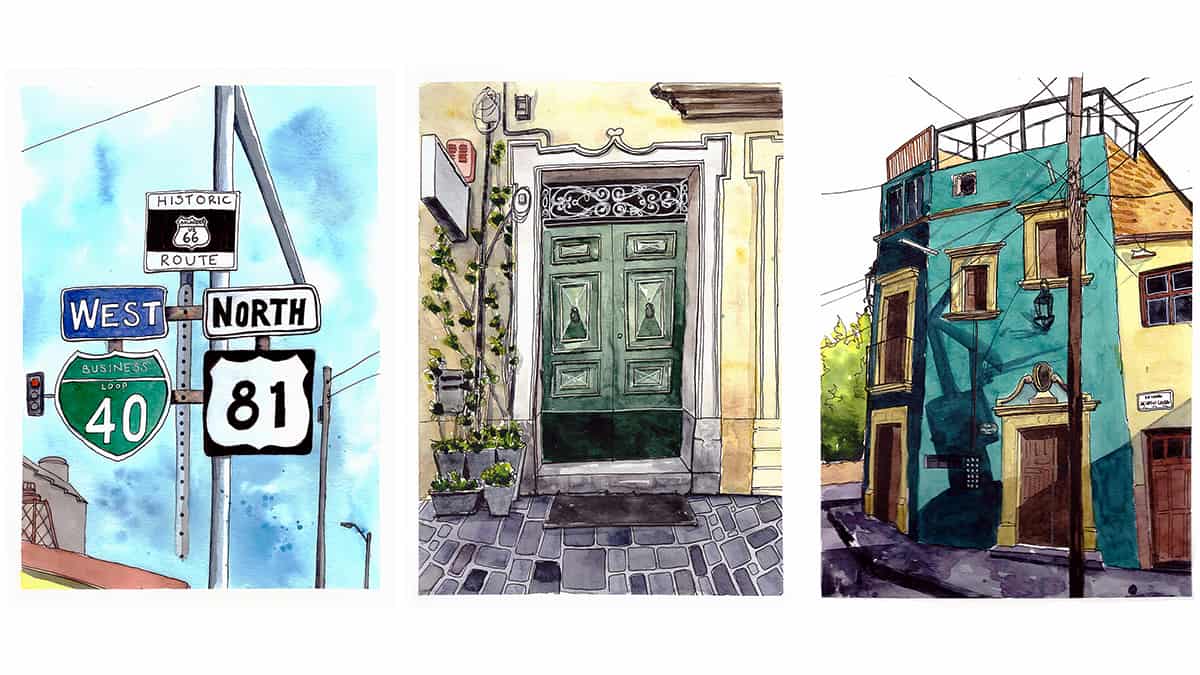
Inspiration
Urban Sketchers to Follow
I have an entire post on some of my favourite urban sketchers, they are some of the most prominent and well-known sketchers involved in the urban sketching movement – and for good reason. Their work is incredible and hugely inspiring. Many of them have taught workshops at the Urban Sketchers Symposium, teach workshops around the world and have courses available online.
Exploring Different Styles of Urban Sketching
Look at the different styles and try to analyse what the artist is doing. Do they use heavy black lines? What colours do they use? Have they sketched a scene in a realistic way or have they interpreted it in a different way? How does the sketch make you feel? Which style excites you the most? Can you identify some of the elements of the style you like and practice with them in your own sketch?
It’s important to understand that you can copy someone’s sketch for the purposes of practice and to try and reverse engineer what a sketcher may be doing. This is a useful and valid learning technique. What you should not do is share this sketch with others on the pretence it is your own work.
Learn more about different urban sketching styles and how to achieve them here.
Going Beyond the Basics
Thumbnail Sketching
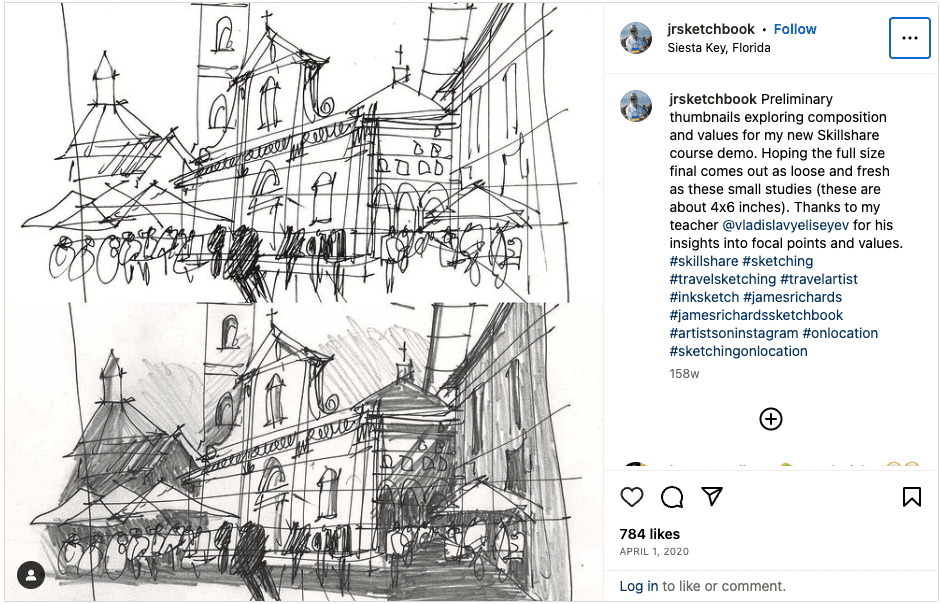
Thumbnail sketching is a great habit to get into and will save you a lot of time and hassle down the road if you intend to sketch a scene for an hour or more.
Thumbnail sketches are small shorthand sketches that allow you to play with various elements of your sketch before committing. You can play with composition, angles, proportions, mediums, light and shadow and colour. It’s an invaluable method to get the most from your sketching time and achieve the sketch you want.
Check out my post here for further details of how to go about producing thumbnail sketches.
Check out my ebooks with hundreds of ink & watercolour travel sketches from all over the world. Get some inspiration for your next trip…
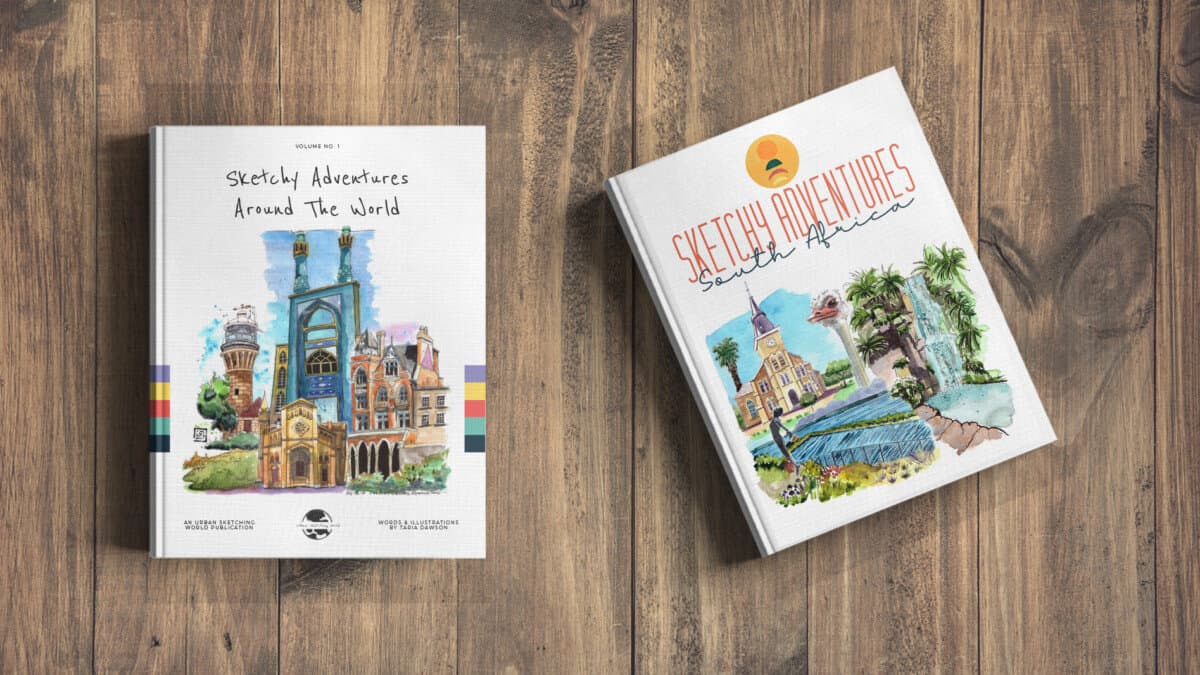
How to Design a Sketchbook Spread
Most urban sketchers use a sketchbook as their weapon of choice to collect sketches together. There’s something magical about building a collection of sketchbooks that contain your memories of places but also become a record of your progression as an artist.
There are many ways to play with the format of the sketchbook to transform it into a piece of art in its own right.
In this post, I discuss how to create sketchbook spreads from collecting many sketches of one thing through to making your own documentary timeline of a place, project or trip.
Some of my favourite online classes
- Daily Sketching for Creative Inspiration – Sorie Kim
- Exploratory Sketchbook: Find Your Drawing Style – Sarah Van Dongen
- Urban Sketching in Mixed Media – Jenny Adam
- Urban Sketching: Express Your World in a New Perspective – Lapin
Experimenting with Different Mediums
Another way to have a lot of fun with urban sketching and explore some different styles and techniques is to play with different mediums. Watercolour is great fun, especially if you keep things nice and loose and splash the paint around!
However, there are other mediums you can try. Gouache is not quite as easy to use on the move but it gives a beautiful flat opaque finish, making it a favourite for animators and designers.
James Gurney does a lot of on-location painting with gouache and his Youtube channel is a treasure trove of wonderful videos where he talks you through as he paints a scene. He is an incredible artist. Be wanted, you may lose a fair few hours to watching his videos but you’ll definitely learn a lot.
Another fun medium to check out are markers, in fact, I have a post about urban sketching with markers here. Again they are not the most portable but if you don’t mind carrying them around with you then they also can be super fun to experiment with.
Check out a video by Katerina Brovka, an incredibly talented artist who uses markers to create incredible illustrations. Please bear in mind, I’m sharing this video is to inspire you, not put you off!
This set of markers by Winsor and Newton on Amazon is a great starting point at a reasonable price if you want to experiment for yourself.
How to Improve Your Urban Sketching Skills
When you’re ready to take a deeper dive into the various elements that can take your sketching to the next level, check out this post where I give you loads of free video resources to teach you the essentials to make your sketches really pop.
Share Your Sketch (If You Want)
Number 7 on the Urban Sketchers Manifesto at the start of this post is “we share our drawings online”. While you are under absolutely no obligation to do this, as you get more confident, you may enjoy the experience of sharing your work with others, especially other sketchers. I have found you can create quite a bond with people all over the world through a shared love of sketching.
Instagram is my favourite place to share my sketches, my personal account is @tarias_sketchy_adventures if you want to check them out. I also share other people’s sketches from all over the world on the Urban Sketching World account which you can find here @urbansketchingworld
There are also many many sketching groups on Facebook that you can join. I most recently joined one called Virtual Sketchwalk, a group designed for people who cannot get outside to sketch for various reasons, from lockdown due to a global pandemic through to having a disability. It’s a lovely inclusive way for everyone to enjoy the magic of urban sketching.
For more information on how to actually scan and edit your artwork in order to share it, you can check out my post here or my video here on Youtube.
Advanced Urban Sketching
Once you have got into the swing of things, you may want to think about taking your urban sketching skills and activities a little further. If so, I have some further posts you may wish to explore:
How to Plan the Ultimate Urban Sketching Trip
I suspect all of the information and resources above will keep you busy for a while! If you have any questions or want to get in touch you can DM me on Instagram or feel free to email me: taria@urbansketchingworld.com – I always reply and I love to hear from fellow sketching enthusiasts, whatever the stage of your journey!
Get Involved!
As mentioned, Urban Sketchers is a non-profit organisation run by volunteers, so if you would like to donate or want to in the future you can do so here. The organisation is periodically looking for volunteers to help with various activities so if you want to get involved then check out their website for more details.
Just to be clear I am not affiliated with the non-profit organisation Urban Sketchers in any way. I run this website due to my absolute love (obsession?) for urban sketching and the desire to encourage and inspire more people to get outside and document the world with a sketchbook.
Final Thoughts…
The main thing is to enjoy the process of urban sketching. It’s such a fantastic hobby, especially if you enjoy travelling, whether that’s exploring and discovering new areas in a 2-hour radius from your home or whether you like hopping across continents.
I know it’s not easy to get caught up in the end result of your sketch and judge it as good as bad but if you can try to get past this and just keep going, over time, you will keep getting better and better. Your sketches will get closer to how you want or expect them to look, you will start experimenting with different techniques and mediums and you will develop your own style. In the process, you will build a collection of sketchbooks over time that is not only a record of your progress in sketching but a collection of your travels too.
If you’d like to take a little look through some of my sketchbooks, I have some flip-through videos over on my Youtube channel. If you start with the earliest sketchbook through to the most recent – you will definitely see a progression in technique and style. I’m always experimenting and trying out new ways of sketching, my style evolves over time, just like all other sketchers.
I hope this inspires you to get out and sketch and that you love this form of art as much as I do.

